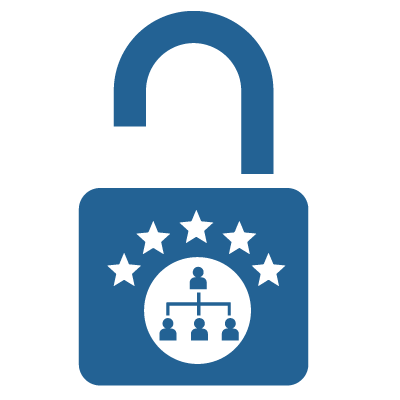When we first meet a client to discuss leadership development, we often hear, “This program is long overdue. Leaders are desperate to get moving with some training.” There's no doubt about the benefits of leadership development. However, companies often put these programs on the back burner to keep up with other business priorities and changes like AI technology and remote work.
Putting a successful program into action requires time. But waiting creates a risk, too—that your leaders will be even less prepared to face those challenges. Ahead, we’ll explore the critical benefits of leadership development and why starting today is essential for any organization to thrive.

Benefit #1: Strong Leadership Foundation
We often talk to companies planning to begin leadership development in six months to a year. This delayed timing frequently leads us to ask, “What are you doing in the meantime?” We usually hear one of two responses: They are doing nothing—leaving their leaders to flounder—or leaning on general e-learning, where leaders access resources via an online content library. In this case, it's up to leaders to choose topics and courses. Learners are often forced to decide how much time to spend on their development and where it falls on their list of priorities.
Organizations without a guided approach don’t reap the benefits of leadership development and are vulnerable to risks, including:
1. Lack of Consistency: When leaders use different sources for guidance, each leader behaves differently. This can negatively impact important things like cross-team collaboration, communication, decision-making, and psychological safety.
2. Misalignment: Leader behaviors may not align with your company's values or business drivers. They won't reinforce a shared company culture or strategic objectives.
3. Decreased Efficiency: If everyone self-seeks their own leadership approach, some leaders may spend no time on development while others spend too much time on low-impact skills.
4. Reduction in Quality: Just because someone spends a lot of time self-seeking how to be a great leader doesn't mean they will actually be one. You want your leaders to draw from science-backed content in settings proven to help them develop and practice new behaviors.
Launching leadership development streamlines the approach to group and individual learning and aligns leadership culture with company values. Ultimately, this ensures leaders have the knowledge, skills, and mindset to collaborate and navigate complex challenges.

Benefit #2: Organizational Performance
Companies sometimes justify delays, saying, “We can’t make time for leadership development.” Their reason? They are too focused on specific business goals to commit bandwidth to learning.
But here’s the thing—your organization’s performance suffers because it delays leadership development. Leaders must enable your strategy. A formal leadership development program ensures a focus on critical leader capabilities, like strategic thinking and preparing for uncertainty. These skills drive critical business outcomes, highlighting a direct link between effective leadership and organizational performance.
We recently worked with a client undergoing significant change and implementing cost-cutting measures. These steps created tremendous strain on managers and their teams, who faced burnout and turnover. The HR team presented a leadership training program to the CEO, but he initially said, “I’m sorry. I just don’t think we have time for this right now.”
Still, the HR team returned. They outlined the benefits of leadership development and how each part of the program connected to the organization’s strategy. Each skill leaders would learn directly impacted the specific metrics the CEO was trying to drive.
By the time they launched their leadership development program, the CEO remarked, “We can’t afford not to do this.” The program had simply become too critical to the company’s overall strategy.

Benefit #3: Employee Engagement and Retention
Employees and leaders are crucial to any organization, and their engagement is the linchpin of any retention strategy. It is challenging to keep employees on board if they are disengaged or feel that the company isn’t invested in their growth.
High-potential talent doesn’t tolerate low-quality leadership. They also need clarity about their path forward. Our research shows that high-potential leaders are 2.4X more likely to want to stay at their companies if they have a leadership development program that helps them accomplish career goals and learn new skills. Moreover, 88% of leaders report feeling more engaged in their leadership roles than before DDI training.
Building great leaders is a retention strategy. Remember: Employees don’t quit their jobs; they quit their bosses. They stay when there is trust and a good rapport with their leaders. So, by investing in leaders, you also set them up to retain their teams.

Benefit #4: Preparedness for Crisis or Change
Employees must feel understood, valued, involved, and supported, especially when navigating a crisis. However, leaders lacking formal training may struggle to mobilize people and resources or adapt to change.
A robust leadership program ensures that leaders learn skills such as resilience and adaptability. But our research shows they aren’t getting the training they need to address future challenges. In a survey of 13,695 leaders from 1,556 organizations worldwide, we identified critical gaps in essential leadership skills, including decision making, prioritization, and managing change.
One of our clients, NewYork-Presbyterian, recently showed how training can help leaders navigate crisis and change. Before 2020, the organization invested in leadership development, focusing on interviewing skills. With a new facility opening, they needed to ensure that managers could select talent with top medical skills who could provide an excellent patient experience.
Then the pandemic hit. The staff were strained beyond what anyone expected. However, the organization had the best possible people to keep it afloat.
As the pandemic wore on and healthcare workers faced burnout, the organization pivoted. They moved to virtual training sessions, changed the competency model, and focused on DEI. But here’s the key: They didn’t have to start from scratch. Instead, NewYork-Presbyterian was able to approach the crisis from a place of strength.
This story is a prime example of the benefits of leadership development and how it prepares organizations to adapt. If NewYork-Presbyterian had not prioritized developing leaders, they would not have been prepared to meet the challenges of the pandemic.

Benefit #5: Leader Bench Strength
A recent study showed that fewer than one in four companies are satisfied with their leadership teams. Yet 83% have cut or neglected their leadership development budgets.
So, what happens next? Neglecting leadership development creates gaps in your pipeline of capable leaders at every level, limiting the pool of qualified talent ready to step into higher-level positions. According to DDI's Global Leadership Forecast 2023, only 12% of organizations have a strong leadership bench, a low number that has declined over the past decade.
Gaps in bench strength leave organizations vulnerable to disruptions, like unexpected departures or an inability to fill priority leadership roles. But when bench strength is strong, performance improves. According to our data, compared to companies with weak benches, companies that report strong benches are:
- 6X more likely to be capable of engaging and retaining top talent.
- 5X more likely to be able to prevent employee burnout.
- 3X more likely to be among financially top-performing organizations.
- 10X more likely to have employees rate their leader quality as “very good” or “excellent.”
The data is clear—a personalized and intentional leadership development program is necessary to keep leaders engaged and build their confidence to take on growth opportunities.
Waiting to Develop Leaders Is a Risk
Organizations must not wait to invest in developing leaders. Many companies support other business priorities, mistakenly thinking that delaying leadership training won’t impact near-term outcomes. They take a “we’ll start tomorrow” approach. They wait for things to settle down. They start their program after a long planning period. But all that actually does is put you further behind.
Think about where you could be a year from now. Do you want to be just getting started? Or do you want to be expanding into your next phase of growth or profitable performance? Your foundation could already be built and yield the benefits of leadership development.
By embracing leadership development, you’ll be ready before you face challenges head-on, before you lose top talent, and before your employees disengage.
It's not just an investment in leadership but in possibilities and your organization's future.
Vicki Center is DDI's Business Development Director. Ms. Center is a sales leader who works closely with DDI clients to deliver talent strategies that enable business and cultural priorities. She leads DDI's Sales Academy and supports global Sales Enablement initiatives and programs.
Topics covered in this blog


